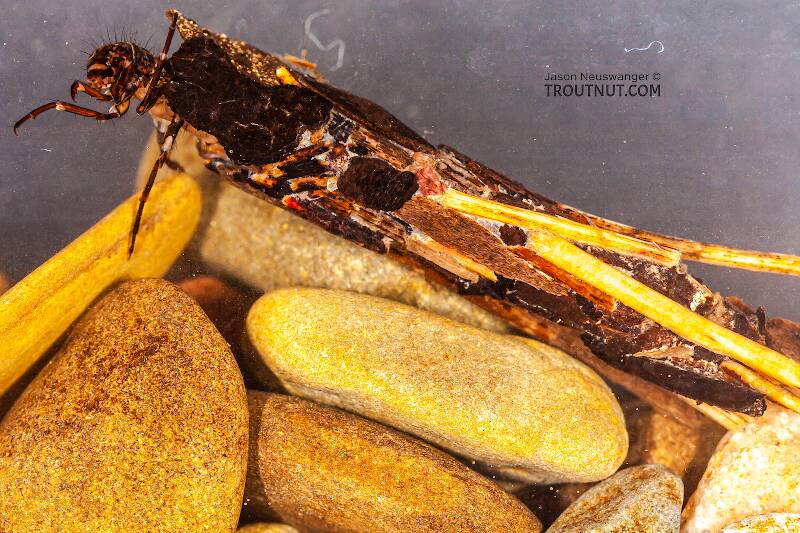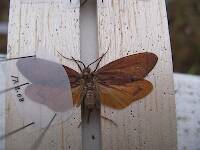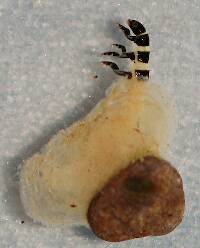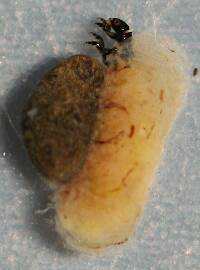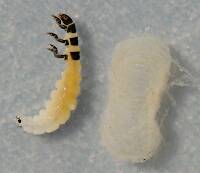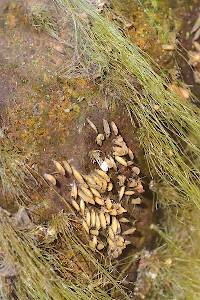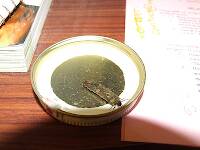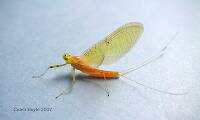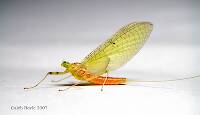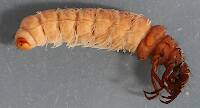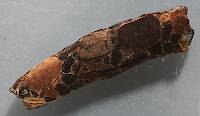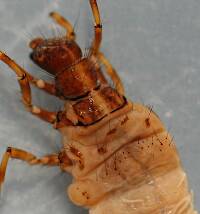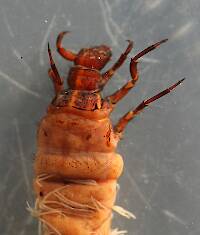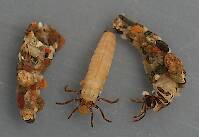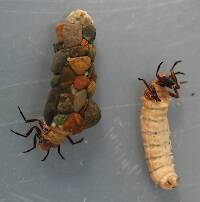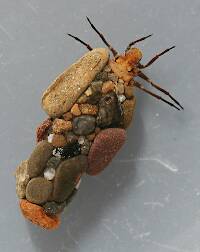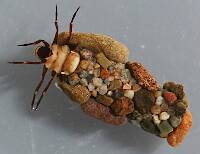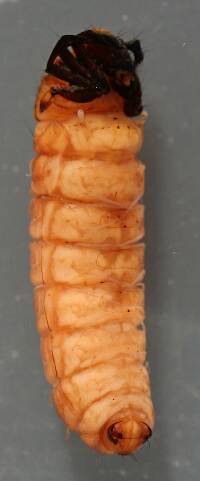
Blue-winged Olives
Baetis
Tiny Baetis mayflies are perhaps the most commonly encountered and imitated by anglers on all American trout streams due to their great abundance, widespread distribution, and trout-friendly emergence habits.
Featured on the forum

I caught this tiny larva without a case, but it seems to key pretty clearly to to Glossosomatidae. From there, the lack of sclerites on the mesonotum points to either Glossosoma or Anagapetus. Although it's difficult to see in a 2D image from the microscope, it's pretty clear in the live 3D view that the pronotum is only excised about 1/3 of its length to accommodate the forecoxa, not 2/3, which points to Glossosoma at Couplet 5 of the Key to Genera of Glossosomatidae Larvae.

Troutnut is a project started in 2003 by salmonid ecologist Jason "Troutnut" Neuswanger to help anglers and
fly tyers unabashedly embrace the entomological side of the sport. Learn more about Troutnut or
support the project for an enhanced experience here.
Earlfishman
Posts: 17
Posts: 17
Earlfishman on Apr 11, 2007April 11th, 2007, 5:28 pm EDT
Find a used copy of Wiggin's "trichoptera larvae of north america" or some similar title. It is the best guide to get to genus for all the caddis you may run across
Quillgordon on Apr 12, 2007April 12th, 2007, 2:14 am EDT
Earl,
Found this.......... FWIW........
Wiggins, G. Larvae of the North American Caddisfly Genera (Trichoptera). 2nd ed. Toronto and Buffalo, NY: University of Toronto Press, 1996.
Qg.
Found this.......... FWIW........
Wiggins, G. Larvae of the North American Caddisfly Genera (Trichoptera). 2nd ed. Toronto and Buffalo, NY: University of Toronto Press, 1996.
Qg.
Flyfishing is a state of mind! .............. Q.g.
C/R........barbless
C/R........barbless
GONZO on Apr 12, 2007April 12th, 2007, 2:32 am EDT
Hi Earl (and John),
Earl, I'm assuming that you're referring to my tentative guess that this might be Pycnopsyche. Actually, it's not that I'm not aware of the more comprehensive keys or where to find them, it's just that I rarely have more than bits and pieces (along with my own experience) to call upon on the spur of the moment. I usually won't comment on a specimen if I'm not pretty sure that it's something I'm familiar with. And I realize that my methods are not scientific.
However, Limnephilids always drive me a little crazy. If you have the Wiggins keys on hand, I'd be interested to know what you can make of this specimen.
Earl, I'm assuming that you're referring to my tentative guess that this might be Pycnopsyche. Actually, it's not that I'm not aware of the more comprehensive keys or where to find them, it's just that I rarely have more than bits and pieces (along with my own experience) to call upon on the spur of the moment. I usually won't comment on a specimen if I'm not pretty sure that it's something I'm familiar with. And I realize that my methods are not scientific.
However, Limnephilids always drive me a little crazy. If you have the Wiggins keys on hand, I'd be interested to know what you can make of this specimen.
Earlfishman
Posts: 17
Posts: 17
Earlfishman on Apr 17, 2007April 17th, 2007, 4:55 am EDT
Gonzo,
Your right, this specimen is Pycnopsyche sp. The key characters that can lead you there are all visible in the above photos. Abdominal gills are single; there is an elongate sclerite posterior to the lateral hump that can be seen in one of the photos; and finally the metanotal sa1 sclerites are not fused on the mid-dorsal line. The case is also fairly characteristic of Pycnopsyche. The only genus that is really confusable is Hydatophylax sp., but in most cases the metanotal sa1 sclerites are fused on that bug.
Those are the characters, but the fact is it just looks like Pycnopsyche.
Hope that helps.
Earl
Your right, this specimen is Pycnopsyche sp. The key characters that can lead you there are all visible in the above photos. Abdominal gills are single; there is an elongate sclerite posterior to the lateral hump that can be seen in one of the photos; and finally the metanotal sa1 sclerites are not fused on the mid-dorsal line. The case is also fairly characteristic of Pycnopsyche. The only genus that is really confusable is Hydatophylax sp., but in most cases the metanotal sa1 sclerites are fused on that bug.
Those are the characters, but the fact is it just looks like Pycnopsyche.
Hope that helps.
Earl
GONZO on Apr 17, 2007April 17th, 2007, 5:15 am EDT
Thanks, Earl. :)
Quick Reply
Related Discussions
Topic
Replies
Last Reply
0
Sep 23, 2006
by Litobrancha
by Litobrancha
21
Feb 19, 2013
by Gutcutter
by Gutcutter
2
Nov 28, 2012
by Brookyman
by Brookyman


